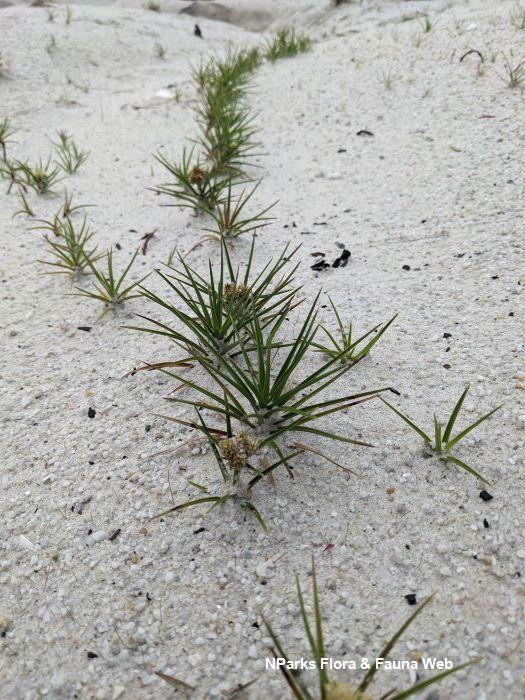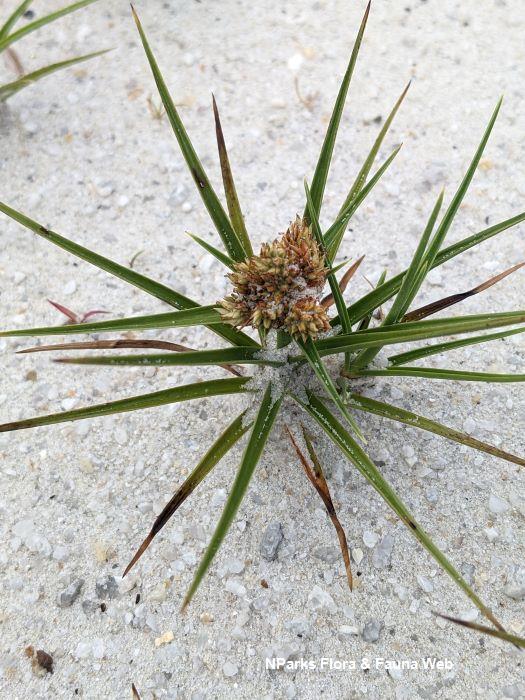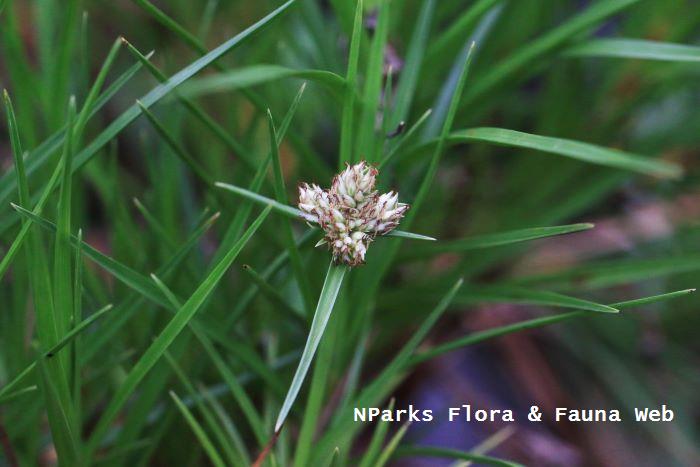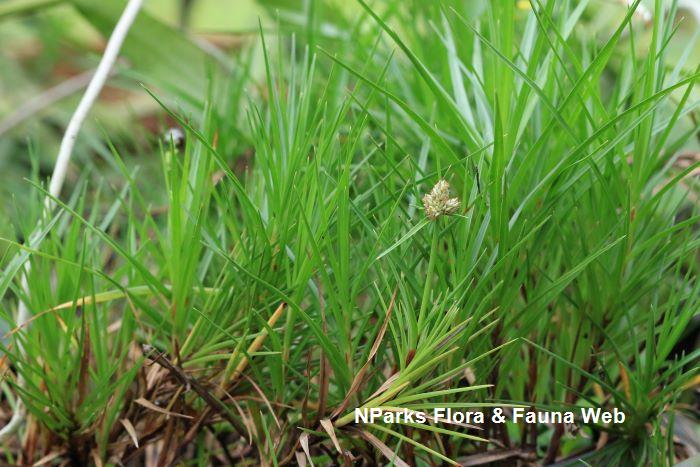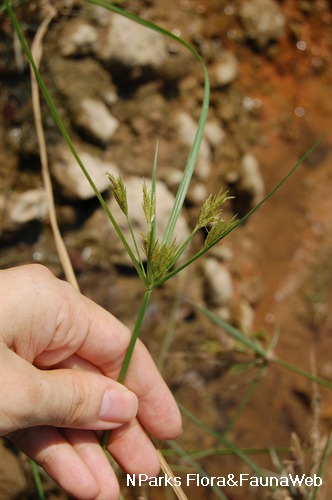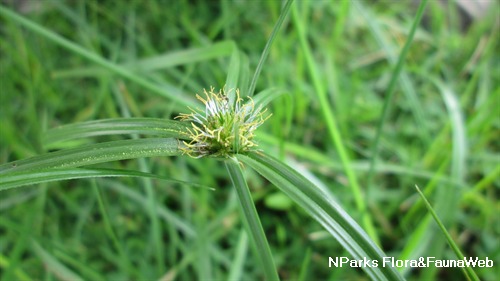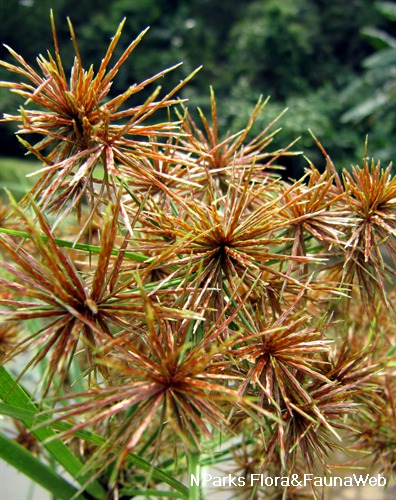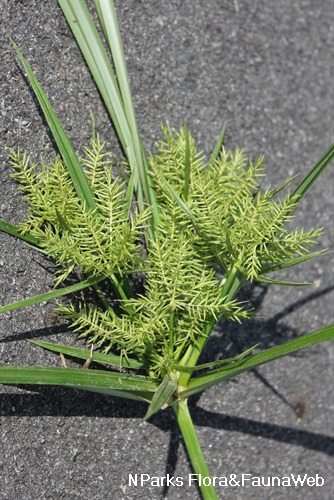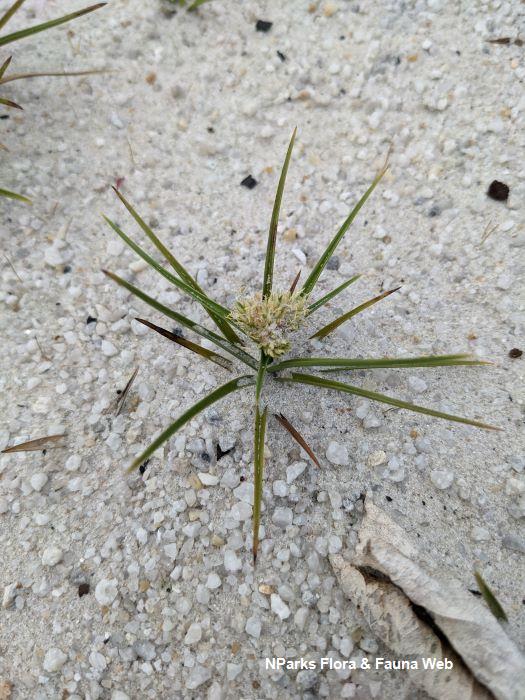
Back
Cyperus pedunculatus (R.Br) J.Kern
| Family Name: | Cyperaceae |
| Synonyms: | Mariscus pedunculatus (R.Br.) T.Koyama, Remirea maritima Aubl., Remirea maritima var. pedunculata (R.Br.) Benth., Remirea pedunculata R.Br. |
Cyperus pedunculatus is a low-growing, rhizomatous sedge that can be found on sandy seashores throughout the tropics, including Singapore. It has a spreading habit, forming rosettes of linear green leaves and a flowerhead of clustered spikelets.
Name
Classifications and Characteristics
| Plant Division | Angiosperms (Flowering Seed Plants) (Monocotyledon) |
|---|---|
| Plant Growth Form | Grass or Grass-like Plant (Sedge (Cyperaceae)) |
| Lifespan (in Singapore) | Perennial |
| Mode of Nutrition | Autotrophic |
| Plant Shape | Grassy |
Biogeography
| Native Distribution | Pantropical |
|---|---|
| Native Habitat | Shoreline (Sandy Beach) |
| Preferred Climate Zone | Tropical |
| Local Conservation Status | Native to Singapore (Least Concern (LC)) |
Description and Ethnobotany
| Growth Form | It is a rhizomatous, perennial sedge, often creeping. |
|---|---|
| Foliage | Its leaves are linear, reaching 3-8 cm long and 4-5 mm wide. The leaf sheaths are 1-1.5 cm long, light brown to reddish-brown. |
| Stems | It has an underground rhizome (horizontal modified stems). |
| Flowers | The flowers are called florets and consist of heavily reduced petals and sepals, three stamens, and three stigmas. The florets are clustered together, forming a spikelet, and arranged tightly in a head; this inflorescence is known as capitulum. |
| Fruit | The fruits are oblong nutlets (achenes in literature), trigonous (triangular in cross-section), and mature to greyish-brown. |
| Habitat | It can be found on sandy seashores, often growing in large colonies on the sides of dunes. |
| Etymology | The genus Cyperus is Greek name for a sedge. The specific epithet pendunculatus possibly refers to the habit of the creeping rhizomes as the inflorescence is not strictly pedunculate. |
Landscaping Features
| Landscape Uses | Coastal, Beachfront / Shoreline |
|---|
Plant Care and Propagation
| Light Preference | Full Sun |
|---|---|
| Water Preference | Moderate Water |
| Plant Growth Rate | Fast to Moderate |
| Rootzone Tolerance | Saline Soils / Salt Spray, Well-Drained Soils |
| Propagation Method | Division, Stem Cutting |
Foliar
| Foliage Retention | Evergreen |
|---|---|
| Mature Foliage Colour(s) | Green |
| Mature Foliage Texture(s) | Smooth |
| Foliar Type | Simple / Unifoliate |
| Foliar Arrangement Along Stem | Rosulate / Rosette |
| Foliar Attachment to Stem | Sessile |
| Foliar Shape(s) | Non-Palm Foliage (Linear) |
| Foliar Venation | Parallel |
| Foliar Margin | Entire |
| Foliar Apex - Tip | Acute |
| Foliar Base | Clasping |
Non - Foliar and Storage
| Root Type | Underground (Fibrous Root) |
|---|
Floral (Angiosperm)
| Flower & Plant Sexuality | Bisexual Flowers |
| Flower Colour(s) | Cream / Off-White, Brown |
|---|---|
| Flower Texture(s) | Smooth |
| Flower Grouping | Cluster / Inflorescence |
| Flower Location | Terminal |
| Inflorescence Type | Head / Capitulum, Spikelet / Compound Spike |
| Ovary Position | Superior / Hypogynous |
| Flowering Habit | Polycarpic |
Fruit, Seed and Spore
| Mature Fruit Colour(s) | Brown, Silver / Grey |
|---|---|
| Mature Fruit Texture(s) | Smooth |
| Fruit Classification | Simple Fruit |
| Fruit Type | |
| Mature Seed Colour(s) | Brown, Silver / Grey |
| Mature Seed Texture(s) | Smooth |
| Seed Quantity Per Fruit | Few (1-5) |
References
| References | Simpson, D.A. (2019). Cyperaceae. Flora of Singapore, Volume 7. Singapore: National Parks Board. 37-211 pp. |
|---|
Image Repository
Others
| Master ID | 34005 |
|---|---|
| Species ID | 8421 |
| Flora Disclaimer | The information in this website has been compiled from reliable sources, such as reference works on medicinal plants. It is not a substitute for medical advice or treatment and NParks does not purport to provide any medical advice. Readers should always consult his/her physician before using or consuming a plant for medicinal purposes. |

